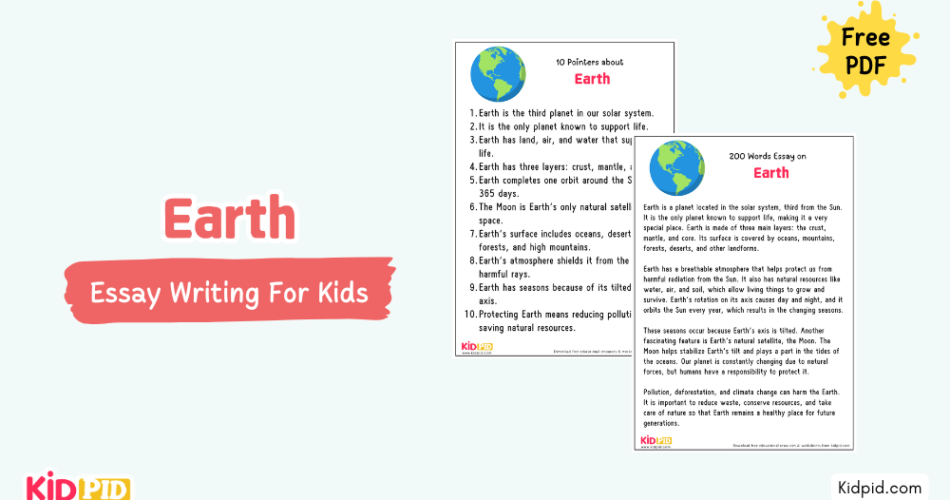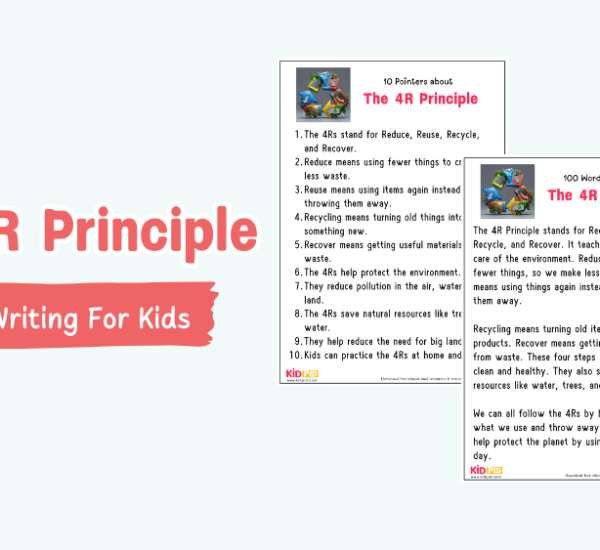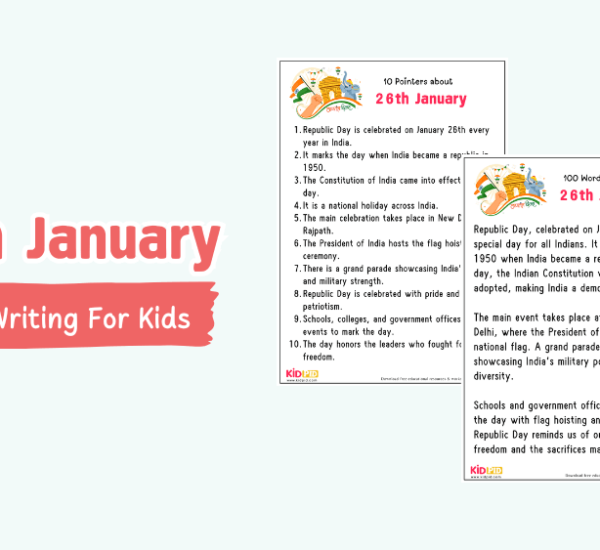Earth is our beautiful home, full of land, water, air, animals, and people. This essay helps children learn about the Earth, its importance, and how we can protect it. With 10 simple pointers and questions, kids will enjoy discovering fun and important facts about the planet we live on.
10 Pointers About Earth

- Earth is the third planet in our solar system.
- It is the only planet known to support life.
- Earth has land, air, and water that support life.
- Earth has three layers: crust, mantle, and core.
- Earth completes one orbit around the Sun in 365 days.
- The Moon is Earth’s only natural satellite in space.
- Earth’s surface includes oceans, deserts, forests, and high mountains.
- Earth’s atmosphere shields it from the Sun’s harmful rays.
- Earth has seasons because of its tilted rotating axis.
- Protecting Earth means reducing pollution and saving natural resources.
Short Essay On Earth
Essay On Earth in 100 Words

Earth is a special planet in our solar system. It is the third planet from the Sun and the only one known to have life. Earth is unique because it has water, land, and air, which make it a perfect place for plants, animals, and humans to live. Earth’s surface has many features, like oceans, forests, deserts, and mountains. It also has an atmosphere that helps protect us from the Sun’s harmful rays. Earth orbits the Sun every year, giving us seasons. It is important to take care of the Earth by reducing pollution and conserving natural resources.
Essay On Earth in 200 Words

Earth is a planet located in the solar system, third from the Sun. It is the only planet known to support life, making it a very special place. Earth is made of three main layers: the crust, mantle, and core. Its surface is covered by oceans, mountains, forests, deserts, and other landforms. Earth has a breathable atmosphere that helps protect us from harmful radiation from the Sun. It also has natural resources like water, air, and soil, which allow living things to grow and survive.
Earth’s rotation on its axis causes day and night, and it orbits the Sun every year, which results in the changing seasons. These seasons occur because Earth’s axis is tilted. Another fascinating feature is Earth’s natural satellite, the Moon. The Moon helps stabilize Earth’s tilt and plays a part in the tides of the oceans.
Our planet is constantly changing due to natural forces, but humans have a responsibility to protect it. Pollution, deforestation, and climate change can harm the Earth. It is important to reduce waste, conserve resources, and take care of nature so that Earth remains a healthy place for future generations.
Essay On Earth in 300 Words
Earth is a unique and beautiful planet that stands out in our solar system. Located third from the Sun, Earth is the only planet known to support life. This makes it incredibly special. Earth’s surface is made up of oceans, forests, deserts, mountains, and more. These landforms and bodies of water provide habitats for countless living creatures, from tiny insects to large mammals. Earth’s atmosphere, made up of gases like oxygen and nitrogen, keeps us safe by blocking harmful rays from the Sun and regulating the temperature.
One of the most interesting things about Earth is its layers. The outer layer is called the crust, and below it lies the mantle, which is made up of hot rock and minerals. At the very center of the Earth is the core, made of iron and nickel. These layers work together to create the conditions that support life.
Earth rotates on its axis, creating day and night. This rotation also causes the Earth to experience different seasons throughout the year. The tilt of Earth’s axis is what causes the seasons to change. Earth also orbits around the Sun, taking 365 days to complete one revolution.
The Moon, Earth’s natural satellite, plays a crucial role in stabilizing Earth’s tilt and affecting the tides in the oceans. While Earth is perfect for supporting life, it is also vulnerable. Human activities like pollution and deforestation can harm our planet. To protect Earth, we must all do our part to conserve natural resources, reduce waste, and protect the environment. Together, we can ensure that Earth remains a safe, healthy home for future generations.
Long Essay On Earth in 500 Words
Introduction
Earth is a fascinating planet in our solar system. It is the third planet from the Sun and the only one known to support life. Earth is home to humans, animals, plants, and countless other living organisms. Our planet is unique, with its land, water, air, and atmosphere, which together create a perfect environment for life to thrive. In this essay, we will explore some key aspects of Earth, including its structure, the forces that shape it, the role of the atmosphere, the importance of water, and the need to protect it.
Structure of Earth
Earth is made up of three main layers: the crust, the mantle, and the core. The crust is the outermost layer, where we live. It is made of solid rocks and minerals and is very thin compared to the other layers. Beneath the crust is the mantle, which is much thicker and made up of hot, semi-solid rock. The core is the innermost layer and is made of iron and nickel. The outer core is liquid, while the inner core is solid due to the high pressure. These layers work together to create the conditions that support life on Earth.
The Atmosphere
The atmosphere is a layer of gases surrounding Earth. It is essential for life because it provides the air we breathe, consisting mainly of oxygen and nitrogen. The atmosphere also acts as a shield, protecting Earth from harmful radiation from the Sun. It helps regulate the temperature, keeping the planet warm enough for life to survive. Without the atmosphere, Earth would be a cold, lifeless place. The atmosphere is also responsible for the weather patterns we experience, including rain, wind, and storms.
Water on Earth
Water is one of Earth’s most important resources. About 71% of Earth’s surface is covered by oceans, and the remaining land is made up of continents and islands. Water is essential for all living things, as it is used for drinking, growing food, and many other activities. There are three main forms of water: liquid (in oceans, rivers, and lakes), solid (in glaciers and ice caps), and gas (in the form of water vapor). The water cycle, which involves evaporation, condensation, and precipitation, ensures that water keeps moving around the planet, providing fresh water for plants, animals, and humans.
Seasons and Earth’s Orbit
Earth experiences four seasons: spring, summer, autumn, and winter. These seasons are caused by Earth’s tilt on its axis and its orbit around the Sun. As Earth orbits the Sun, different parts of the planet receive varying amounts of sunlight, which leads to changes in weather and temperature. In the summer, the hemisphere tilted towards the Sun experiences warmer weather, while the opposite hemisphere experiences winter. The changing seasons are essential for many plants and animals, as they help regulate growth cycles and migration patterns.
Protecting Earth
While Earth is a beautiful and life-sustaining planet, it is facing many challenges. Human activities such as pollution, deforestation, and the overuse of natural resources are harming the environment. Pollution from factories, cars, and waste can damage the air, water, and soil. Deforestation, or the cutting down of trees, reduces the number of plants that help clean the air and provide homes for wildlife. It is important to protect the Earth by reducing pollution, conserving resources, and planting trees. Small actions like recycling, saving water, and reducing waste can make a big difference in protecting our planet for future generations.
Conclusion
Earth is a remarkable planet that supports a wide variety of life. Its structure, atmosphere, and water resources make it the perfect place for living organisms to thrive. However, it is our responsibility to protect Earth from harm and ensure it remains a safe and healthy place for all. By learning about Earth and taking action to protect it, we can help preserve our planet for future generations.
FAQs on Earth
Q1. Which planet is Earth in order from the Sun?
Ans. Earth is the third planet from the Sun.
Q2. Why is Earth special compared to other planets?
Ans. It is the only planet known to support life.
Q3. Name the three main layers of the Earth.
Ans. Crust, mantle, and core.
Q4. What protects Earth from the Sun’s harmful rays?
Ans. The atmosphere protects Earth.
Q5. What causes the seasons on Earth?
Ans. Earth’s tilt on its axis causes seasons.
Q6. What is Earth’s natural satellite?
Ans. The Moon is Earth’s natural satellite.
Q7. What percentage of the Earth is covered by water?
Ans. About 71% of the Earth is covered by water.
Q8. Why is water important for life on Earth?
Ans. Water is needed for drinking, growing food, and survival.
Q9. How does Earth’s rotation affect day and night?
Ans. Earth’s rotation on its axis causes day and night.
Q10. List two ways we can help protect the Earth.
Ans. We can reduce pollution and conserve natural resources.
Earth gives us everything we need to live. This essay, along with 10 easy pointers and questions, teaches children to love, respect, and take care of our planet every day. Visit our website to discover a wide range of paragraphs, essays, worksheets, flashcards, Quizzes, and other interactive resources. Don’t forget to follow us on YouTube and Facebook.
You might also like
Essay – The Legacy of a European Scientist/Artist/Leader

The essay “The Legacy of a European Scientist/Artist/Leader” shares the incredible story of Albert Einstein. It explains his theory of relativity, E=mc², Nobel Prize, peace efforts, and lasting impact on science and humanity.
Essay – The Ethical Dilemmas Faced By Churchill During WWII

“The Ethical Dilemmas Faced by Churchill During WWII” essay explores tough decisions Winston Churchill made—like choosing whether to fight or seek peace, balancing bombings with civilian safety, and handling alliances during the war.
Essay – Newton And Einstein: Foundational Physics Discoveries

“Newton and Einstein: Foundational Physics Discoveries essay” explains how Isaac Newton’s laws of motion and gravity and Albert Einstein’s theories of relativity (E=mc²) changed how we understand movement, space, time, and the universe.
Essay – Karl Marx

Karl Marx’s essay introduces the 19th-century German philosopher who studied class struggle and fairness. He co-wrote The Communist Manifesto, encouraged workers to unite, and developed ideas on equality and social change.
Essay – Plato

Plato’s essay explores the life of the ancient Greek philosopher who studied under Socrates. He founded The Academy, wrote The Republic, taught the Theory of Forms and the Allegory of the Cave, shaping ideas on justice and knowledge.






